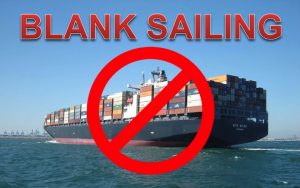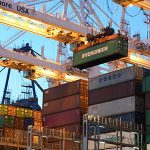Blank Sailings Help Maersk Profit Despite COVID-19 — Will Blank Sailings Continue?
 From when the novel coronavirus outbreak in China first started registering in international shipping news, stories have been published about how ocean freight carriers could or would lose millions to billions of dollars in 2020 because of the spreading disease that quickly escalated into a full-blown pandemic. As an example from one of many such stories over the last few months,
From when the novel coronavirus outbreak in China first started registering in international shipping news, stories have been published about how ocean freight carriers could or would lose millions to billions of dollars in 2020 because of the spreading disease that quickly escalated into a full-blown pandemic. As an example from one of many such stories over the last few months,
In [Murphy’s] best-case scenario, in which volume decline 10% and rates hold relatively firm, carriers would lose an aggregate of $800 million. Under his worst-case scenario, in which both volumes and rates decline to the same degree they did in 2009, carriers would collectively lose $23 billion this year.
Therefore, it came as a surprise to many that Maersk, the world’s largest ocean carrier by capacity, managed to post a profit for the first quarter of 2020. Mike Wackett reports in an article for the Loadstar:
The company recorded a net profit of $197m in the first quarter, compared with a loss of $69m in the same period of 2019, while group turnover edged up $0.3% to $9.6bn, “driven by ocean”, it said.
So how did Maersk manage to do better in the ocean freight business, posting a profit during the first quarter of this pandemic-stricken year, than the company did this time a year ago? Two words: blank sailings.
Blank Sailings
As we’ve rounded up the effects of the COVID-19 pandemic on international shipping, blank sailings have pretty consistently topped the list.

Blank Sailing
Blank sailings is the fancy term the international shipping industry uses for cancelled ship sailings. Blank sailings are commonly utilized by carriers and typically frustrating for shippers. For shippers, blank sailings mean delayed delivery of goods, but carriers use them to control capacity and increase profits.
During this pandemic, ship sailings have been cancelled by the hundreds.
Not only has this affected delivery time for goods, but all the blank sailings have created issues in getting needed shipping container supplies to port locations, even creating difficulty for many shippers to return containers on time. The latter has resulted in unfair coronavirus-related detention fees.
Some of the early blank sailings were due to port or terminal shutdowns over fear of spreading the novel coronavirus. However, most blank sailings have been about greatly reducing capacity to keep freight rates up during the significant drop in demand. Maersk’s first quarter profit, as well as the fact that freight rates have been higher so far this year compared to the same period last year, shows the blank sailing strategy has been effective.
Will Blank Sailings Continue?
Greg Knowler wrote an article for the Journal of Commerce that tells us, yes, Maersk will continue blank sailing through the quarter of the year we are in:
Maersk Line will cancel up to 140 sailings in the second quarter on the east-west trades as the carrier attempts to match its capacity with a predicted 20 to 25 percent decline in volume.
It was a strategy that was successfully deployed in the first three months of the year as the coronavirus disease 2019 (COVID-19) began to crush demand. The 90 sailings that were blanked as demand fell and the higher freight rates compensated for an increase in the price of low-sulfur fuel and allowed the carrier to report a profitable start to the year.
Of course, Maersk is not alone in cancelling containership voyages. Blank sailing has been happening across the industry from shipping lines in every carrier alliance. To get a feel for how much blank sailing is happening, here are the recently announced blank sailings compiled in Knowler’s article:
The 2M Alliance of Maersk Line and Mediterranean Shipping Co. has blanked 27 sailings on Asia-North Europe, withdrawing 511,940 TEU, while cutting 233,479 TEU from Asia-Med in 16 blank sailings. On Asia-US trades, 45 sailings have been blanked, withdrawing 369,432 TEU.
Ocean Alliance carriers (CMA CGM, Cosco Shipping, OOCL, and Evergreen) have now canceled 28 sailings on Asia-North Europe comprising 437,031 TEU, and 16 sailings on Asia-Med, withdrawing 152,460 TEU. Asia-US trades have seen 60 canceled sailings that have cut 578,115 TEU.
THE Alliance (Hapag-Lloyd, Yang Ming, and Ocean Network Express) has blanked 19 sailings of 297,100 TEU on Asia-North Europe, and 17 sailings on Asia-Med of 232,046 TEU. On Asia-US routes, 63 sailings have been blanked, removing 483,231 TEU.
Still, while we expect blank sailings to keep coming through this quarter, they could slow over the second half of the year as lockdowns over COVID-19 are easing. In fact, blank sailing announcements have already begun to slow from what we have been seeing through this year. Greg Miller wrote an American Shipper article that asks the question of whether carriers will scale back sailing cancellations:
Arrival schedules for May and June are set. U.S. ports will see double-digit declines in inbound capacity. Whether carriers will keep “blanking” (canceling) sailings on the same scale into the third quarter remains unknown — but not for much longer.
If mass cancellations extend into July at elevated May-June levels, it means that carriers are not receiving enough bookings from shippers, implying a weak recovery after social distancing restrictions are lifted. If carriers move back in the direction of pre-coronavirus scheduling levels, it’s a positive signal on demand.
…
The good news is that blank-sailing announcements have been waning.
According to Alan Murphy, CEO of Copenhagen-based Sea-Intelligence, “Over the last week, carriers have only announced an additional six blank sailings across the main deep-sea trades, which clearly shows that we have reached a plateau, where carriers are now only blanking very few additional sailings, and for the moment are satisfied that the currently announced blank-sailings program is sufficient to underpin the freight rate levels.”
While we’ll know more in the upcoming weeks, it does appear blank sailings will not continue at the level we’ve seen, but there is a big factor in how things will play out for U.S. shippers to take into account…
The Battle of Reopening
There is a growing conflict in the U.S. over the reopening of the economy. There is a great deal of fear over reopening. Obviously, the fear is that infections and deaths will spike if we do so. On the other side, the longer we remain shutdown, the deeper economic damage is done through the increase of businesses closed for good, jobs lost, and increases in mental health damages and people in poverty.
Not surprisingly, the Republicans and Democrats of congress have done more for the relief of big businesses like the airlines than small businesses and individuals during this crisis. One thing that means is the longer shutdowns continue, the more spending power of consumers wanes. That decrease in demand for goods means a decrease in demand for international shipping.
In the meantime, people are fighting over whether to reopen. From those I’ve spoken to, the ones who most want things to remain closed are people who are not largely impacted by the closures in a financial way. They are able to work from home or are retired and receiving a pension (most of whom likely fall in the higher risk groups for succumbing to the novel coronavirus). Many of those who desperately want the economy reopened have had their livelihood taken away or seriously put in jeopardy. They’re people whose businesses are closed or jobs have been lost or suspended.
Unfortunately, once an economy has been closed, it is difficult to reopen. And when more power is granted to a government and the people in control of it, the harder it is to get that power back. People, and therefore governments, do not easily give up power. However, lost freedom builds discontent and resentment, which can lead to revolt. We’re seeing some of that revolt now with protests and business owners refusing to obey shutdown orders and reopening against government and even court orders.
Unfortunately, we don’t know how the spread of the novel coronavirus will increase upon reopening. The experts disagree wildly. We don’t even know the death rate of this disease, not only because we have no way of knowing how many asymptomatic people are infected, but because there is controversy over cause of death reporting, highly varying statistics about death rates, and the problem of most reporting being focused on political agendas rather than the truth about what’s actually happening with the virus. I’ve seen death rate numbers being spread from significantly less than 0.01% all the way up to more than 5%. We know it is not nearly as high as that top end, but we have no way of knowing how low it actually is.
All of that does not mean being cautious is not a legitimate approach to reopening. There is a risk to health and lives here. However, we do know that the longer the shutdowns and social distancing rules remain in place, the more people will be without means to pay their bills and buy food, let alone buy goods and create demand anywhere close to what was seen before the pandemic started. How long this battle rages on will likely determine how deep of a recession or depression we fall into. That, obviously, will factor largely into how the international shipping industry looks through the rest of this year and beyond.




